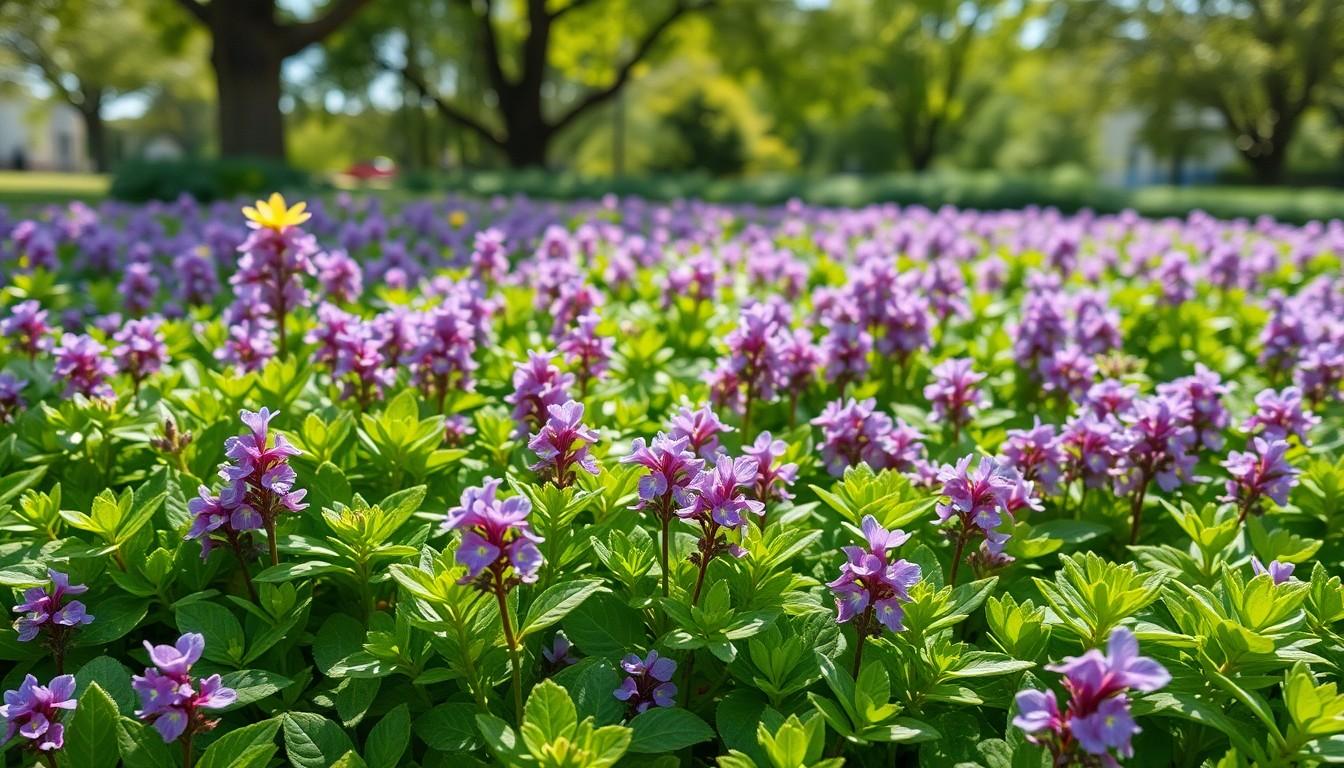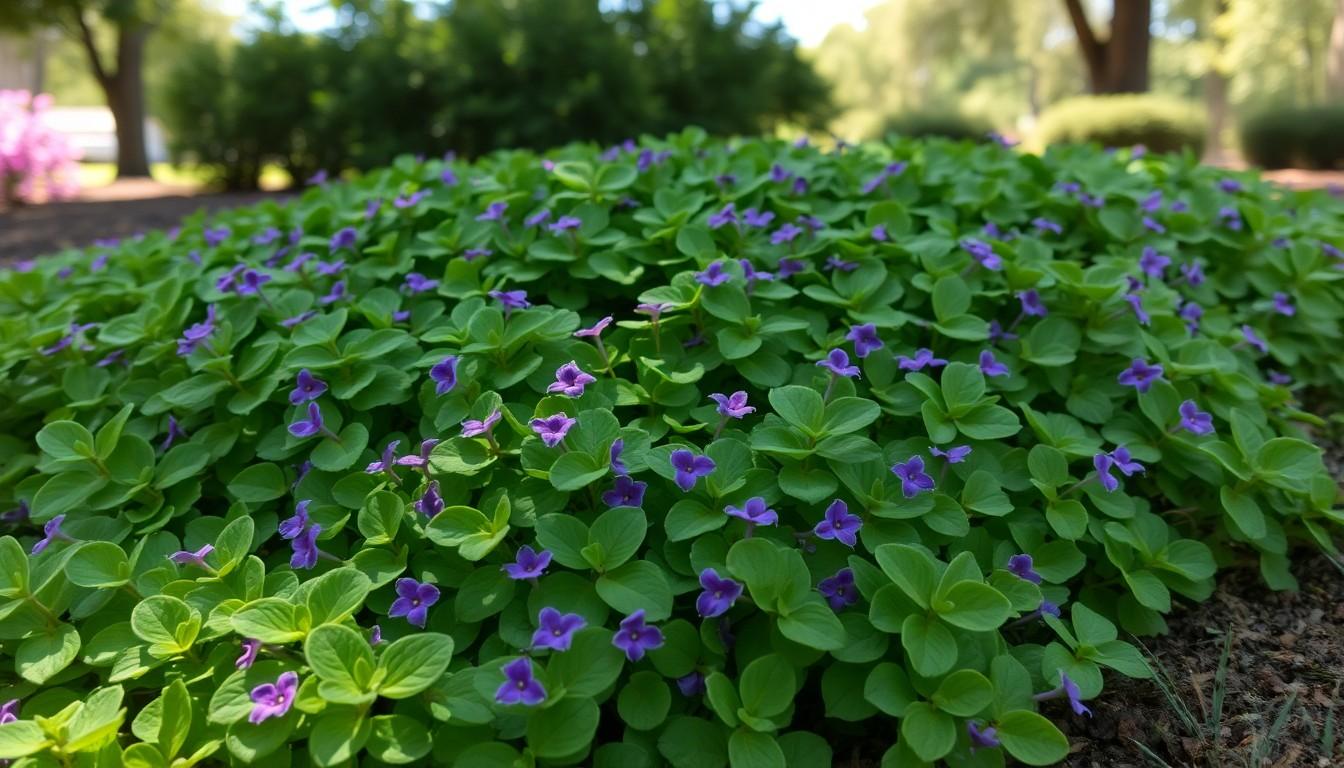Creeping Charlie might sound like the name of a quirky uncle, but this charming little plant is a favorite among gardeners. With its vibrant green leaves and creeping habit, it’s the perfect solution for filling those pesky bare spots in your garden. But don’t let its laid-back vibe fool you; Creeping Charlie has its own set of needs that must be met to thrive.
Creeping Charlie Plant Care
Creeping Charlie, scientifically known as Glechoma hederacea, grows well in various environments, making it a favorite for many gardeners. This hardy perennial produces small, purple flowers in spring, adding a splash of color to landscapes. Its leaves, often described as round and textured, create a lush ground cover that helps suppress weeds.
Light conditions influence its growth significantly. While the plant prefers partial shade, it adapts to full sun and thrives in moist, well-draining soil. Regular watering maintains optimal moisture levels, especially during dry spells, although it can tolerate brief periods of drought.
Fertilization also plays a crucial role in maintaining Creeping Charlie’s health. Applying a balanced fertilizer during the growing season supports robust growth. Guidelines suggest using a liquid fertilizer every four to six weeks to ensure it receives the necessary nutrients.
Pest and disease management is important for plant care. Common issues include aphids and fungal infections, easily addressed with insecticidal soap and proper air circulation. Monitoring the plant regularly helps catch problems early, preventing severe damage.
Creeping Charlie’s ability to spread quickly makes it a versatile choice for covering bare soil but requires management to prevent it from overtaking gardens. Regular trimming helps maintain its shape and encourages fuller growth. Gardeners often use edging or barriers to contain its spread effectively.
Overall, emphasizing proper light, water, and nutrient conditions helps Creeping Charlie flourish, creating a vibrant and resilient ground cover.
Importance of Proper Care
Proper care of Creeping Charlie ensures its vibrant appearance and health. This plant thrives when given the right conditions and attention.
Benefits of Growing Creeping Charlie
Creeping Charlie offers various advantages in garden settings. It serves as an effective ground cover, filling in bare spots and suppressing weeds. Small purple flowers add beauty to landscapes in spring. Dense leaf coverage retains moisture in soil, benefiting surrounding plants. This plant also attracts pollinators, supporting local ecosystems. Additionally, its adaptability allows it to thrive in diverse environments, making it suitable for many gardeners.
Common Misconceptions
Misunderstandings exist regarding Creeping Charlie’s growth habits. Some believe it’s invasive, causing unchecked spread. While it grows rapidly, proper management prevents overreach in gardens. Others think it requires excessive sunlight; in reality, it thrives best in partial shade. Another common myth claims it needs poor soil. Healthy growing conditions, such as well-draining, moist soil, enhance its vitality. Understanding these facts promotes successful Creeping Charlie cultivation.
Watering Requirements
Creeping Charlie requires consistent moisture to thrive. Proper watering practices significantly impact its growth and overall health.
Frequency and Amount
Watering frequency depends on environmental factors. Typically, Creeping Charlie needs watering once a week during dry periods. Adjustments may be necessary for extreme heat or humidity. Soil should remain consistently moist but not soggy. Use enough water to saturate the soil to encourage deep root development. A good practice involves monitoring the soil moisture level, aiming for an average depth of about 2 to 3 inches.
Signs of Overwatering and Underwatering
Recognizing signs of overwatering prevents damage. Yellowing leaves often indicate too much water. Additionally, wilting can occur when roots suffocate in overly saturated soil. Conversely, underwatering leads to noticeable drooping and leaf discoloration. Leaves may also appear crispy along the edges if moisture is insufficient. It’s vital to observe these signs for timely intervention. Adjusting the watering schedule helps maintain the plant’s health.
Light Conditions
Creeping Charlie flourishes under the right light conditions. Optimal growth occurs in partial shade, where the plant receives indirect sunlight.
Ideal Light Levels
Four to six hours of filtered sunlight daily promotes healthy growth. Morning sun followed by afternoon shade works best for Creeping Charlie. Bright, indirect light fosters vibrant foliage and supports vigorous spreading. The plant adapts to full sun, but consistent watering becomes crucial in those conditions. Spotting overexposure involves looking for signs like leaf scorch or wilting.
Effects of Insufficient Light
Inadequate light leads to leggy growth and sparse foliage. Insufficient exposure may cause a plant to become weak and less vigorous. Reduced flowering also occurs, as Creeping Charlie depends on light for blooming its charming purple flowers. Affected plants may struggle to thrive and become more susceptible to pests and diseases. Adjusting light exposure enhances overall health and appearance, ensuring robust growth and vitality.
Soil Type and Fertility
Creeping Charlie thrives best in specific soil conditions that enhance its growth and vitality. Both soil type and fertility play crucial roles in supporting this plant.
Recommended Soil Composition
Ideal soil for Creeping Charlie consists of a mix of loamy and sandy textures, ensuring good drainage while retaining necessary moisture. This plant prefers a pH level between 6.0 and 7.0, which supports nutrient absorption. Incorporating organic matter, such as compost or well-rotted manure, improves soil fertility and structure. Amending soil with these additions creates an optimal environment for root development and overall plant health.
Fertilization Tips
Using a balanced liquid fertilizer promotes healthy growth for Creeping Charlie. A fertilizer with equal parts nitrogen, phosphorus, and potassium is recommended every four to six weeks during the growing season. Applying fertilizer during active growth ensures nutrient availability when needed most. Avoid over-fertilizing, as this can lead to excessive foliage growth at the expense of flowering. Regular soil testing helps determine nutrient needs and prevents deficiencies, ultimately enhancing the plant’s resilience.
Pruning and Maintenance
Creeping Charlie requires regular pruning to maintain its appealing appearance and prevent overgrowth.
How to Prune Creeping Charlie
Pruning involves cutting back stems and leaves to encourage a denser growth habit. Early spring, just before blooming starts, provides the perfect time to prune. Gardeners can use sharp shears to trim back any unruly stems, ensuring a neat and compact form. Removing any dead or yellowing foliage also promotes overall health. Regular pruning every few weeks during the growing season can keep the plant looking fresh, while also allowing for better airflow, reducing the risk of disease.
Managing Growth and Spread
Managing growth helps prevent Creeping Charlie from becoming invasive in garden beds. Planting barriers or edging around desired areas controls its spread effectively. Regular trimming not only maintains its shape but also reduces the potential for unwanted expansion into other areas. Observing the plant’s growth pattern aids in early detection of overreach. When it begins to creep beyond intended boundaries, timely intervention allows gardeners to maintain control. This proactive approach ensures Creeping Charlie remains a vibrant ground cover without overtaking other plants.
Regular maintenance
Creeping Charlie can be a stunning addition to any garden when cared for properly. By providing the right light, moisture, and nutrients, this resilient plant thrives and enhances outdoor spaces. Regular maintenance such as pruning and monitoring soil conditions helps keep it in check and prevents invasiveness.
With its ability to suppress weeds and attract pollinators, Creeping Charlie not only beautifies gardens but also supports local ecosystems. By following these care guidelines, gardeners can enjoy the lush green foliage and charming blooms that make Creeping Charlie a beloved choice for ground cover.
